Yellow birds in Nevada are a rare and stunning sight that captures the attention of both locals and visitors. These vibrantly colored birds, with their yellow feathers and melodious songs, add a splash of brightness to the arid landscapes of the state.
While several bird species can be found in Nevada, the yellow birds stand out for their unique beauty and distinctive characteristics.
In this article, we will explore the different yellow bird species that call Nevada their home, their habitats, behaviors, and the conservation efforts underway to protect these remarkable avian wonders. Prepare to be dazzled by the enchanting world of yellow birds in Nevada.
1. American Goldfinch
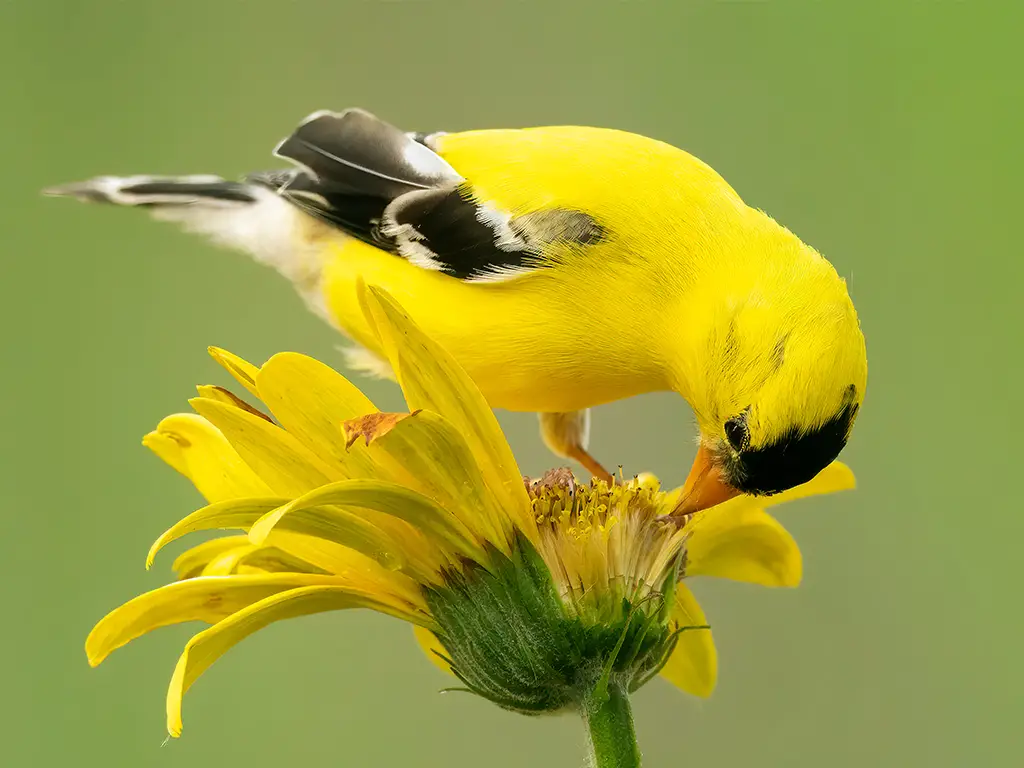
The American goldfinch is a type of bird that is found in North America.
It belongs to the finch family, which is a group of small birds known for their colorful feathers and pleasant songs. This bird is migratory, meaning it travels from one place to another depending on the time of year.
During the breeding season, which is when they mate and lay eggs, the American goldfinch can be found in an area ranging from mid-Alberta in Canada to North Carolina in the United States. In the winter, when the weather gets colder, the American goldfinch migrates to a different region.
They move from just south of the Canada–United States border and travel down to Mexico.
This helps them find better conditions for survival, as the temperature and food availability change with the seasons. The reason for their migration is mainly related to the availability of food.
During the breeding season, the American goldfinch feeds on insects and seeds from plants like sunflowers and thistles.
These food sources are abundant in the areas where they breed, providing them with the necessary nutrients for reproduction and raising their young. However, during the winter, these insects and plants may not be readily available in their breeding grounds.
| Kingdom | Animalia |
| Phylum | Chordata |
| Clade | Dinosauria |
| Class | Aves |
| Order | Passeriformes |
| Family | Fringillidae |
| Genus | Spinus |
| Species | S. tristis |
2. New World Warblers

The New World warblers, also known as wood-warblers, are a type of small bird that can be found in the Americas. These birds are often vibrant and eye-catching, with colorful plumage that stands out in their surroundings.
They belong to the family Parulidae, which is a group of passerine birds, meaning they have specialized feet for perching. Unlike some other bird species, New World warblers are only found in the Americas. They are not seen in other parts of the world, such as Europe or Asia.
This geographical restriction sets them apart from Old World warblers, which are found in Europe, Asia, and Africa.
Similarly, they are not closely related to Australian warblers, which are native to Australia and nearby regions. The New World warblers have their distinct characteristics and evolutionary history.
Although they may share some similarities in behavior or appearance with other warbler species, they have evolved separately and have distinct genetic lineages.
Their unique adaptation to the New World environment has shaped their physical traits and behaviors. One of the notable features of New World warblers is their colorful plumage. Many species exhibit vibrant hues of yellow, blue, green, and red, making them a delight to observe.
| Kingdom | Animalia |
| Phylum | Chordata |
| Clade | Dinosauria |
| Class | Aves |
| Order | Passeriformes |
| Family | Parulidae |
3. Yellow-Rumped Warbler

The yellow-rumped warbler is a type of bird that is found in North America. It is quite common and can be seen in many different places across the continent. This bird species is known for its distinct yellow feathers on its rump, or lower back.
This is where it gets its name from. These yellow feathers make it easy to identify the yellow-rumped warbler in the wild. The yellow-rumped warbler is a small bird, measuring around 5 to 6 inches in length. It has a slim body with a pointed beak and long wings.
Its wingspan can reach up to 9 to 10 inches, allowing it to fly swiftly and gracefully. One interesting fact about this bird is that it is known for its ability to migrate long distances. During the breeding season, yellow-rumped warblers can be found in North America.
However, when winter arrives, they migrate south to warmer regions, such as Mexico and Central America. This bird species can be found in a variety of habitats. It is often seen in forests, woodlands, and even urban areas.
It has adapted well to different environments and can thrive in both deciduous and coniferous forests. The yellow-rumped warbler has a diverse.
| Kingdom | Animalia |
| Phylum | Chordata |
| Clade | Dinosauria |
| Class | Aves |
| Order | Passeriformes |
| Family | Parulidae |
| Genus | Setophaga |
| Species | S. coronata |
4. Yellow Warbler

The paragraph talks about the yellow warbler, which is a type of New World warbler species. The yellow warbler belongs to a diverse genus called Setophaga.
It is known to be the most widespread species among the Setophaga genus. Yellow warblers have a wide distribution and can be found breeding in various regions. They are known to inhabit almost the entire North American continent.
In addition to North America, they also breed in the Caribbean, which includes several islands in the area.
Furthermore, yellow warblers can be found breeding in the northern parts of South America. The fact that yellow warblers breed in such a vast range of locations highlights their adaptability and ability to thrive in different habitats.
This adaptability may be attributed to their ability to find suitable food sources and nesting grounds in different environments. By breeding in diverse regions, yellow warblers contribute to the overall biodiversity of the areas they inhabit.
Their presence adds to the richness and variety of bird species found in North America, the Caribbean, and northern South America. It is fascinating to think about the journey these yellow warblers undertake during migration.
They travel long distances to reach their breeding grounds and then return to their wintering grounds, which can be as far away as Central or.
| Kingdom | Animalia |
| Phylum | Chordata |
| Clade | Dinosauria |
| Class | Aves |
| Order | Passeriformes |
| Family | Parulidae |
| Genus | Setophaga |
| Species | S. petechia |
5. Yellow-Headed Blackbird

The yellow-headed blackbird is a type of bird that falls under the category of medium-sized blackbirds. One distinguishing feature of this bird is its bright yellow head. It is unique in its appearance because most blackbirds have dark-colored heads.
This vibrant yellow color on the head of the yellow-headed blackbird makes it easily recognizable. This bird belongs to the genus Xanthocephalus. A genus is a category in the classification system used to group similar species.
In this case, the yellow-headed blackbird is the only member of the genus Xanthocephalus.
This means that there are no other species of birds that share the exact characteristics and features of the yellow-headed blackbird. Being the only member of its genus makes the yellow-headed blackbird quite special and distinct from other birds.
It has its own unique set of characteristics and traits that set it apart from other blackbirds.
This uniqueness contributes to its identity and plays a significant role in differentiating it from other species. The yellow-headed blackbird’s medium size, combined with its distinct yellow head, makes it easily identifiable in its natural habitat.
It stands out among other blackbirds due to its bright and vibrant coloration.
| Kingdom | Animalia |
| Phylum | Chordata |
| Clade | Dinosauria |
| Class | Aves |
| Order | Passeriformes |
| Family | Icteridae |
| Genus | Xanthocephalus |
| Species | X. xanthocephalus |
6. Lesser Goldfinch

The lesser goldfinch is a tiny bird that can be found in the Americas. It belongs to a group called the New World goldfinch clade, along with two other species called the American goldfinch and Lawrence’s goldfinch.
All three species are part of the Spinus genus. One interesting characteristic of the lesser goldfinch is that the males have a black forehead. This feature is unique to male lesser goldfinches and is not present in females.
So, if you see a goldfinch with a black forehead, you can be sure it is a male lesser goldfinch. The black forehead is an important identification feature for distinguishing between male and female lesser goldfinches.
It helps birdwatchers and researchers determine the gender of these birds.
When observing a group of lesser goldfinches, they can easily spot the males with their distinctive black foreheads. It is worth noting that this black forehead trait is not exclusive to the lesser goldfinch.
Both the American goldfinch and Lawrence’s goldfinch also possess this characteristic.
This similarity in appearance suggests a close evolutionary relationship between these three species. By studying these New World goldfinches, scientists can gain insights into their evolutionary history and understand how different.
| Kingdom | Animalia |
| Phylum | Chordata |
| Clade | Dinosauria |
| Class | Aves |
| Order | Passeriformes |
| Family | Fringillidae |
| Genus | Spinus |
| Species | S. psaltria |
7. Common Yellowthroat

The common yellowthroat, a small bird, is commonly found in North America. It belongs to the New World warbler family. This bird is also known by other names such as the yellow bandit or Maryland yellow-throat.
The common yellowthroat is quite prevalent and can be found in large numbers throughout North America. It is a species that breeds extensively in this region. Its breeding range stretches from the southern parts of Canada to the central regions of Mexico.
The yellow bandit is known for its distinctive appearance, with its vibrant yellow throat and breasts. This coloring is what gives the bird its common name.
However, it is important to note that both male and female yellowthroats exhibit this yellow coloration, although the males tend to have a more pronounced and vibrant hue. These birds have a small size, typically measuring around 4.7 to 5.1 inches in length.
They have round bodies with short tails and a relatively long bill. The common yellowthroat also features a distinctive black mask that extends from its eyes across its face, which further adds to its unique appearance.
In terms of behavior, the common yellowthroat is known for its agility and quick movements. It is quite active and often observed flitting.
| Kingdom | Animalia |
| Phylum | Chordata |
| Clade | Dinosauria |
| Class | Aves |
| Order | Passeriformes |
| Family | Parulidae |
| Genus | Geothlypis |
| Species | G. trichas |
8. Western Tanager
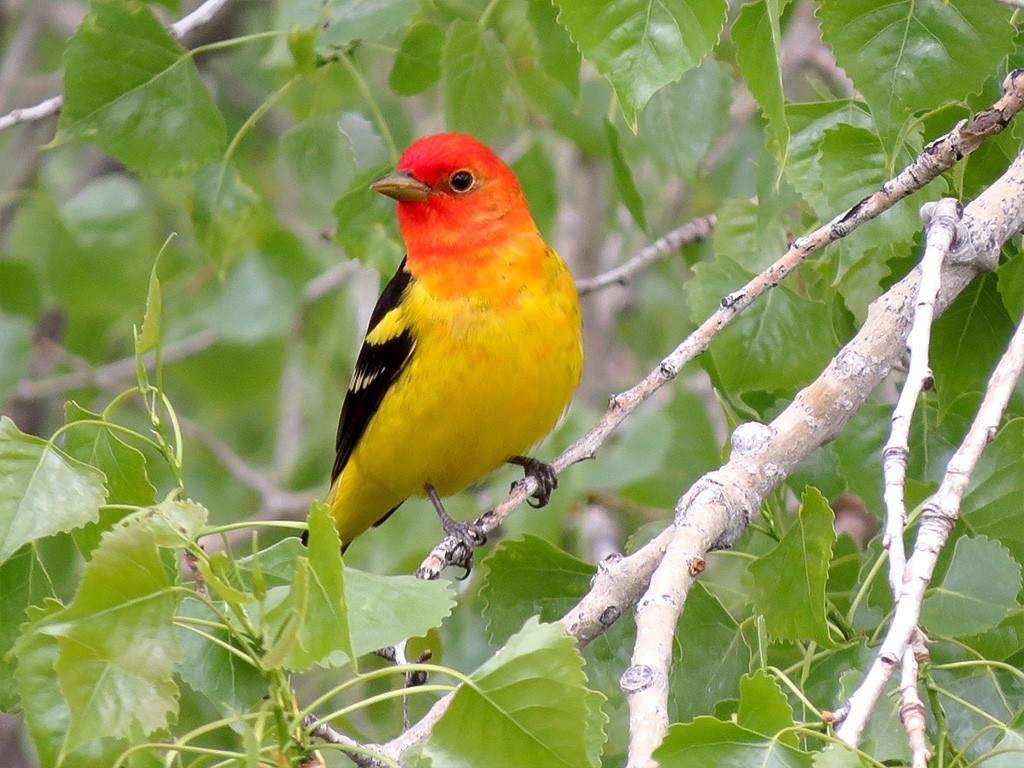
The western tanager is a type of bird that is found in America. It is not very big, but also not too small. In the past, it was thought to belong to the tanager family.
However, now it is classified with other birds in the cardinal family. When we talk about its appearance, the western tanager has certain features that are similar to other birds in the cardinal family.
This includes its feathers or plumage, which have a resemblance to the feathers of other cardinal family members.
Additionally, the way it makes sounds or vocalizes is also similar to other birds in the cardinal family. So, to summarize, the western tanager is an American songbird that used to be considered part of the tanager family but is now classified in the cardinal family.
Its physical appearance and the way it communicates through vocalizations are similar to other birds in the cardinal family.
| Kingdom | Animalia |
| Phylum | Chordata |
| Clade | Dinosauria |
| Class | Aves |
| Order | Passeriformes |
| Family | Cardinalidae |
| Genus | Piranga |
| Species | P. ludoviciana |
9. Wilson’s Warbler

The Wilson’s warbler is a type of small bird that belongs to the New World warbler family. It is known for its distinctive appearance and characteristics. One notable feature of the Wilson’s warbler is its coloration.
The bird has a greenish hue on its upper body, while its lower body is yellow. This combination of colors makes it easily distinguishable from other birds. In terms of its physical structure, the Wilson’s warbler has rounded wings and a long, slim tail.
These features allow it to maneuver and fly swiftly through its natural habitat. Another interesting aspect of this bird is the difference in appearance between males and females. The male Wilson’s warbler has a black crown patch on its head.
However, it’s important to note that the presence of this mark can vary depending on the subspecies. In some cases, the mark may be reduced or completely absent in the female warblers.
Overall, the Wilson’s warbler is a fascinating bird with its greenish and yellow coloration, rounded wings, and long, slim tail. The distinction in appearance between males and females adds an extra layer of intrigue to this beautiful species.
| Kingdom | Animalia |
| Phylum | Chordata |
| Clade | Dinosauria |
| Class | Aves |
| Order | Passeriformes |
| Family | Parulidae |
| Genus | Cardellina |
| Species | C. pusilla |
10. Western Kingbird
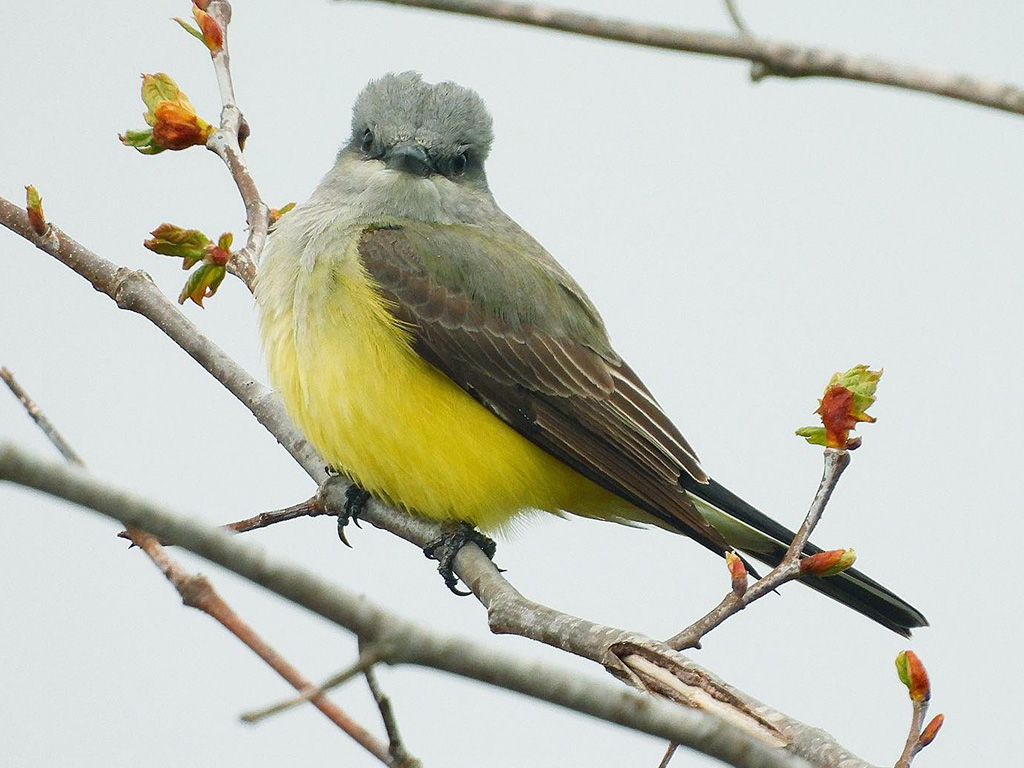
The western kingbird is a species of bird called a tyrant flycatcher. It is commonly found in various western regions of North America. This bird is quite large compared to other flycatchers.
It can be seen in places as far south as Mexico. The western kingbird has adapted well to the western environments it inhabits. It can thrive in diverse habitats such as forests, grasslands, and even urban areas.
This adaptability makes it a common sight in many locations across western North America. One distinctive feature of the western kingbird is its ability to catch insects while flying. As a flycatcher, it has a specialized diet that mainly consists of insects.
This bird is known for its remarkable agility and precision in capturing its prey mid-flight. The western kingbird possesses unique physical characteristics. It has a sturdy build with a length of around 7 to 9 inches (17 to 23 centimeters).
Its plumage is generally gray on the upperparts, while the underparts are pale yellow. It also has a black tail with white outer edges, making it easily identifiable. During the breeding season, the western kingbird showcases its territorial behavior.
| Kingdom | Animalia |
| Phylum | Chordata |
| Clade | Dinosauria |
| Class | Aves |
| Order | Passeriformes |
| Family | Tyrannidae |
| Genus | Tyrannus |
| Species | T. verticalis |
11. Cedar Waxwing
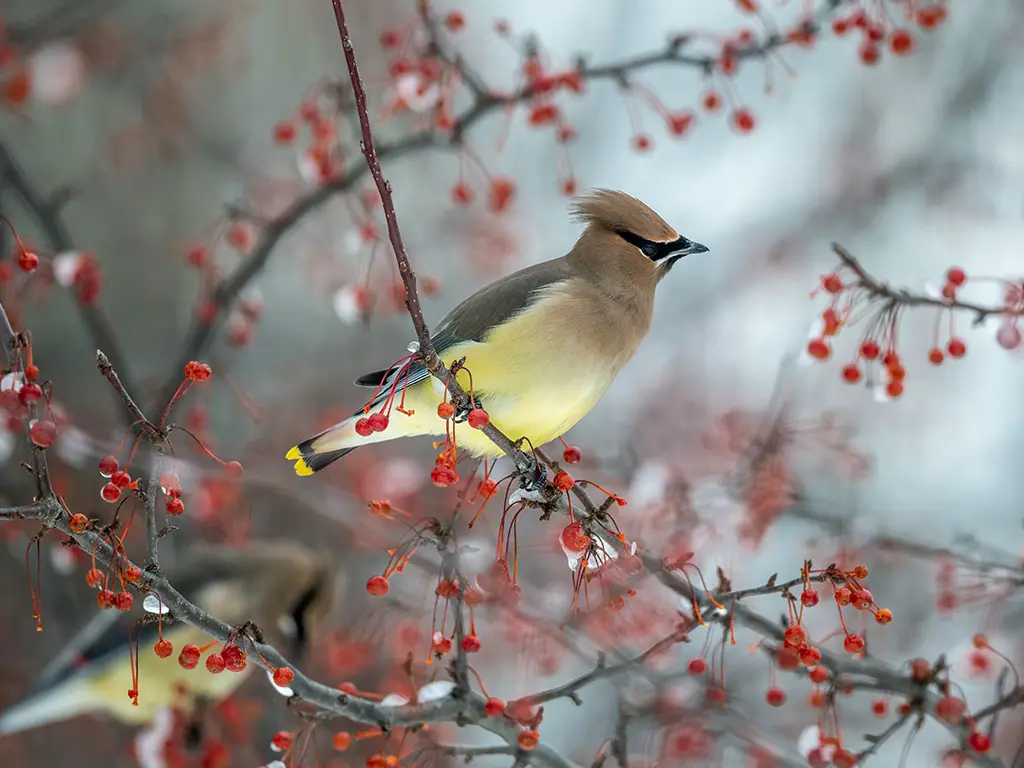
The cedar waxwing is a type of bird that belongs to the waxwing family of passerine birds, known as Bombycillidae. Passerine birds are perching birds, which means they have feet adapted for gripping branches.
The cedar waxwing is a medium-sized bird with a distinctive appearance. Its feathers are mostly brown, gray, and yellow.
These colors help the bird blend well with its surroundings, making it harder for predators to spot it. One of the most unique features of the cedar waxwing is its wings. The bird gets its name from the wax-like tips on its wings.
These wing tips look as if they have been dipped in wax, giving the bird a fascinating and memorable look. The wax-like wing tips serve a purpose for the cedar waxwing. They are specialized feathers that help the bird in various ways.
The waxy substance on the wing tips repels water, allowing the bird to fly more easily in wet weather conditions. It also helps the bird glide smoothly through the air, reducing air resistance. Another interesting aspect of the cedar waxwing is its diet.
This bird primarily feeds on fruits, such as berries, and small fruits like cherries. It has a unique adaptation in it.
| Kingdom | Animalia |
| Phylum | Chordata |
| Clade | Dinosauria |
| Class | Aves |
| Order | Passeriformes |
| Family | Bombycillidae |
| Genus | Bombycilla |
| Species | B. cedrorum |
12. Western Meadowlark

The western meadowlark is a type of bird that belongs to the icterid family. It is considered to be medium in size, measuring about 8.5 inches in length. This bird is commonly found in the western and central regions of North America.
One interesting characteristic of the western meadowlark is its nesting behavior. Unlike many other birds, it builds its nest on the ground instead of in trees or bushes. This nesting preference is particularly common in open grassland areas.
In terms of diet, the western meadowlark primarily feeds on bugs. It has a preference for insects, which make up a significant portion of its diet. However, this bird is not solely dependent on bugs for sustenance.
It also consumes seeds and berries, making its diet relatively diverse. The western meadowlark’s choice of habitat and nesting location is closely tied to its diet. By living in open grasslands, it has easy access to the bugs it relies on for food.
Additionally, this habitat provides an ample supply of seeds and berries, which serve as alternative food sources for the bird. Overall, the western meadowlark is an interesting bird species that can be found across western and central North America.
| Kingdom | Animalia |
| Phylum | Chordata |
| Clade | Dinosauria |
| Class | Aves |
| Order | Passeriformes |
| Family | Icteridae |
| Genus | Sturnella |
| Species | S. neglecta |
13. Evening Grosbeak
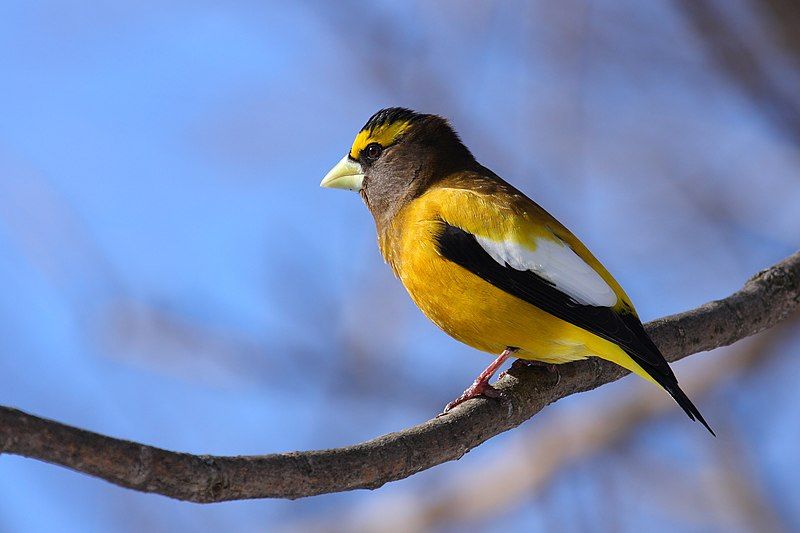
The evening grosbeak is a type of bird that belongs to the finch family and is found in North America. It is known for its bulky body, large bill, and short tail. Scientists have classified it under the genus Hesperiphona.
| Kingdom | Animalia |
| Phylum | Chordata |
| Clade | Dinosauria |
| Class | Aves |
| Order | Passeriformes |
| Family | Fringillidae |
| Genus | Hesperiphona |
| Species | H. vespertina |
14. Scott’s Oriole

The Scott’s oriole is a type of bird that belongs to the icterid family. It is considered to be medium-sized in terms of its physical characteristics.
This species of oriole is mainly found in the Southwestern region of the United States, extending down to Baja California Sur in Mexico. It also inhabits parts of central Mexico.
Interestingly, Scott’s oriole is quite prevalent in the Sacramento area of California, as well as in the southern parts of the state. It is commonly sighted in these areas, which suggests that it has adapted well to the local environment.
The scientific description of Scott’s oriole was first conducted by a French ornithologist named Charles Lucien Bonaparte. He conducted this research and provided a detailed description of the species in the year 1838.
Bonaparte’s work has played a significant role in our understanding of this bird.
| Kingdom | Animalia |
| Phylum | Chordata |
| Clade | Dinosauria |
| Class | Aves |
| Order | Passeriformes |
| Family | Icteridae |
| Genus | Icterus |
| Species | I. parisorum |
15. Nashville Warbler
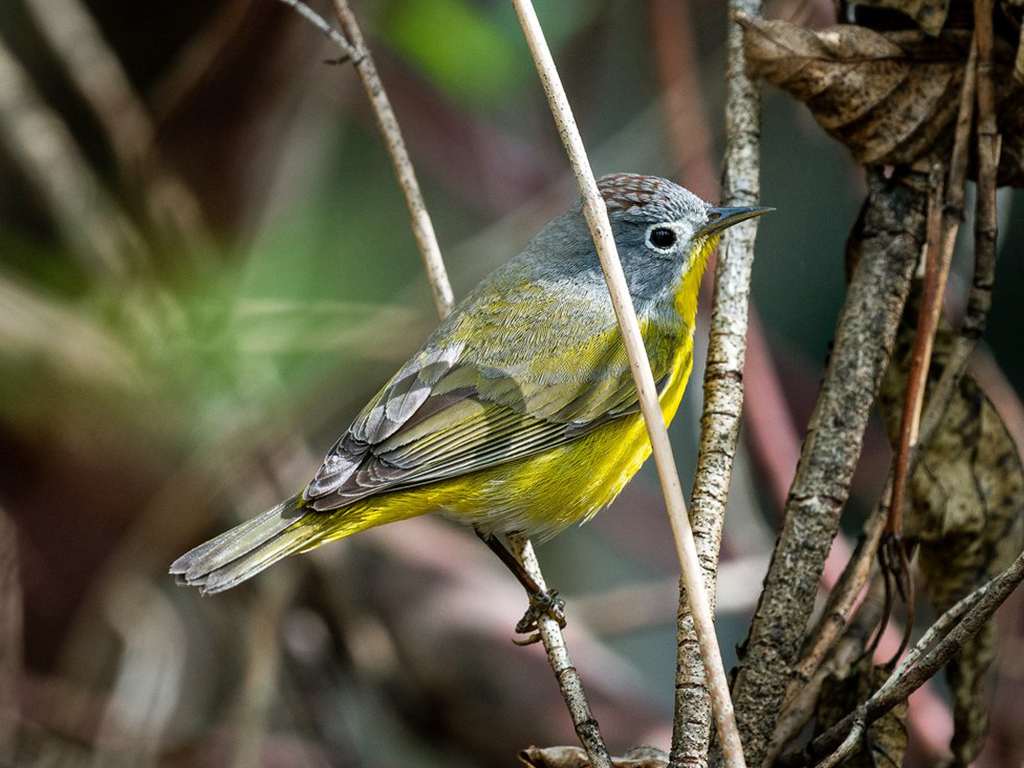
The Nashville warbler is a tiny bird that belongs to the New World warbler family. It can be found in North and Central America. During the breeding season, it resides in certain areas of the northern and western United States, as well as southern Canada.
However, when the winter arrives, the Nashville warbler migrates to different regions. During the winter months, the Nashville warbler flies to southern California and Texas. These warmer areas provide a more suitable habitat for the birds during this time of the year.
The Nashville warbler also travels further south, reaching Mexico and even the northern parts of Central America. Migration is a natural behavior for many bird species, including the Nashville warbler.
The process of migration allows the bird to find more favorable conditions for survival and reproduction.
By moving to warmer regions during the winter, the Nashville warbler can access adequate food sources and avoid harsh weather conditions. The Nashville warbler’s migration pattern is remarkable.
It demonstrates the bird’s ability to navigate long distances, relying on internal compasses and environmental cues.
This small songbird undertakes an incredible journey, crossing various landscapes and habitats, to reach its wintering grounds. The Nashville warbler’s migration serves a vital purpose. It ensures survival and well.
| Kingdom | Animalia |
| Phylum | Chordata |
| Clade | Dinosauria |
| Class | Aves |
| Order | Passeriformes |
| Family | Parulidae |
| Genus | Leiothlypis |
| Species | L. ruficapilla |
16. Yellow-Breasted Chat
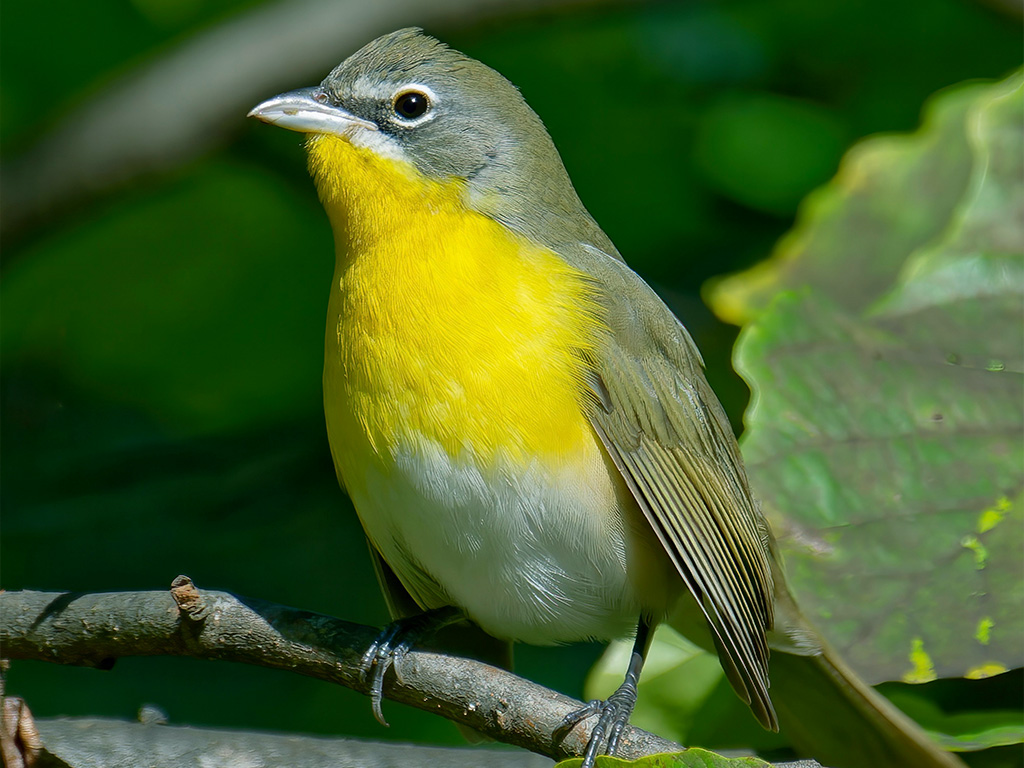
The yellow-breasted chat is a bird that can be found in North America. It is known for its vibrant yellow breast. Interestingly, it is the only member of its family, called Icteriidae. Previously, this bird was considered a part of the New World warbler family.
However, in 2017, the American Ornithological Society made a significant change. They decided to move the yellow-breasted chat to its own family, separate from the warblers.
This change in classification was made because of certain distinct characteristics and behaviors that set the yellow-breasted chat apart from the warblers. By separating it into its own family, scientists hope to better understand and study this unique bird.
Despite this reclassification, the placement of the yellow-breasted chat is still not completely resolved. It means that there is ongoing debate and discussion among experts about where exactly it belongs in the bird classification system.
This uncertainty may stem from the fact that the yellow-breasted chat shares some similarities with both the warblers and other songbirds. Its distinct features and behaviors make it challenging to determine its precise classification.
However, scientists continue to study and observe the yellow-breasted chat to gain more insights into its evolution.
| Kingdom | Animalia |
| Phylum | Chordata |
| Clade | Dinosauria |
| Class | Aves |
| Order | Passeriformes |
| Family | Icteriidae |
| Genus | Icteria |
| Species | I. virens |
17. Hooded Oriole

The hooded oriole is a type of bird that can be found in the New World. It is considered to be a medium-sized bird, not too big and not too small. The male hooded oriole is known for its beautiful and vibrant colors.
Its feathers can range from a bright orange to a paler yellow shade. The male hooded oriole has distinctive black markings on its body. These black markings can be seen on its back, face, tail, and bib.
These black patches create a striking contrast against the bright orange or yellow feathers.
The male hooded oriole also has two white bars on its wings, which add an interesting touch to its appearance. In contrast, the female hooded oriole has a different coloration compared to the male. Her feathers are more of an olive color with some yellow accents.
This coloring helps the female blend in with her surroundings and provides camouflage while she is nesting or foraging for food. Overall, the hooded oriole is a visually appealing bird.
The male’s bright orange or yellow feathers, combined with the black markings and white bars on its wings, make it a beautiful sight to behold. On the other hand, the female’s more subtle.
| Kingdom | Animalia |
| Phylum | Chordata |
| Clade | Dinosauria |
| Class | Aves |
| Order | Passeriformes |
| Family | Icteridae |
| Genus | Icterus |
| Species | I. cucullatus |
18. Hooded Warbler

The hooded warbler is a type of bird that belongs to the New World warbler family. It is found in eastern North America, specifically across the eastern United States and even in the southernmost parts of Canada.
These birds have a wide breeding range in this region. During the winter season, hooded warblers migrate to different areas. They travel to Central America and the West Indies, where they spend the colder months.
This migration is a natural behavior for hooded warblers, allowing them to find more favorable conditions for survival during the winter. Despite their extensive breeding and wintering range, hooded warblers are considered to be rare vagrants in Western Europe.
This means that they are not commonly seen in this part of the world.
The occurrence of hooded warblers in Western Europe is infrequent and unusual, making it a noteworthy event for birdwatchers and ornithologists. Their distinctive feature is the hood-like black marking on the males’ heads, which gives them their name.
This black hood contrasts with their bright yellow underparts, making them easily identifiable. The females, on the other hand, have a less pronounced hood and are generally more dull in color. Hooded warblers prefer forested.
| Kingdom | Animalia |
| Phylum | Chordata |
| Clade | Dinosauria |
| Class | Aves |
| Order | Passeriformes |
| Family | Parulidae |
| Genus | Setophaga |
| Species | S. citrina |
19. Townsend’s Warbler
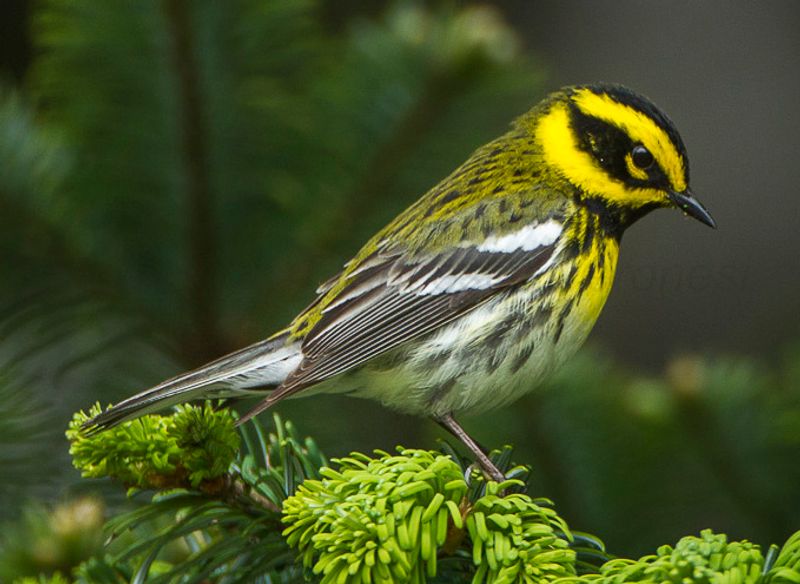
Townsend’s warbler is a type of small bird that belongs to the New World warbler family. This family of birds is known for their beautiful songs and colorful plumage.
The Townsend’s warbler, like other members of its family, is found mainly in North America. This warbler species is named after John Kirk Townsend, a naturalist who explored and studied various species of birds in the 19th century.
The Townsend’s warbler is known for its striking appearance and distinctive features. It has a bright yellow body with black streaks and a black cap on its head.
Its wings also display a combination of black and white feathers. In terms of size, Townsend’s warbler is relatively small, measuring about 4.5 to 5 inches in length.
Despite its small size, it possesses a strong and agile flight, allowing it to navigate through the dense foliage of trees where it usually resides. The habitat of the Townsend’s warbler includes coniferous forests, especially those found in the western regions of North America.
These forests provide the ideal environment for the warbler’s breeding and nesting activities. The species migrates during the winter to areas further south, such as Mexico and Central America.Like other warblers, Townsend.
| Kingdom | Animalia |
| Phylum | Chordata |
| Clade | Dinosauria |
| Class | Aves |
| Order | Passeriformes |
| Family | Parulidae |
| Genus | Setophaga |
| Species | S. townsendi |
20. Northern Flicker

The northern flicker is a type of bird that belongs to the woodpecker family. It is not a very large bird, but it is also not too small. The northern flicker can be found in many parts of North America.
It is also native to some areas in Central America, such as Cuba and the Cayman Islands. One interesting thing about the northern flicker is that it is one of the few woodpecker species that migrate.
Migration means that these birds travel from one place to another during different seasons. They do this to find food and suitable habitats.
The northern flicker migrates to different regions depending on the time of year. During the breeding season, which is usually in the spring or summer, the northern flicker can be found in many parts of North America.
They build their nests in trees and use their strong beaks to create holes in the wood. These holes are called cavities and serve as their homes. Northern flickers are known for their distinctive markings.
They have a brown body with black spots, and their wings have a white patch that is easily visible when they fly. Another unique feature is the red or yellow coloration on the underside of their wings and tail, which can be seen when they.
| Kingdom | Animalia |
| Phylum | Chordata |
| Clade | Dinosauria |
| Class | Aves |
| Order | Piciformes |
| Family | Picidae |
| Genus | Colaptes |
| Species | C. auratus |
21. Yellow-Throated Warbler

The yellow-throated warbler is a type of bird that is small in size and known for its migratory behavior. It belongs to the New World warbler family, which is a group of songbirds found in the Americas.
Specifically, this species can be found in temperate regions of North America. The yellow-throated warbler is characterized by its vibrant yellow throat, which distinguishes it from other warbler species. This feature gives the bird its name.
Its body is generally small, making it easy to identify among other bird species. Being a migratory bird means that the yellow-throated warbler undertakes long-distance journeys between different habitats depending on the seasons.
During the breeding season, it can be found in temperate North America, where it nests and raises its young.
As the colder months approach, the warbler migrates to warmer regions, such as Central America or the Caribbean. Migratory behavior is common among many bird species, as they seek suitable environments for breeding, feeding, and survival.
These journeys can span thousands of miles and require a great deal of energy. The yellow-throated warbler, like other migratory birds, relies on its instincts and navigational abilities to find its way along.
| Kingdom | Animalia |
| Phylum | Chordata |
| Clade | Dinosauria |
| Class | Aves |
| Order | Passeriformes |
| Family | Parulidae |
| Genus | Setophaga |
| Species | S. dominica |
22. Dickcissel
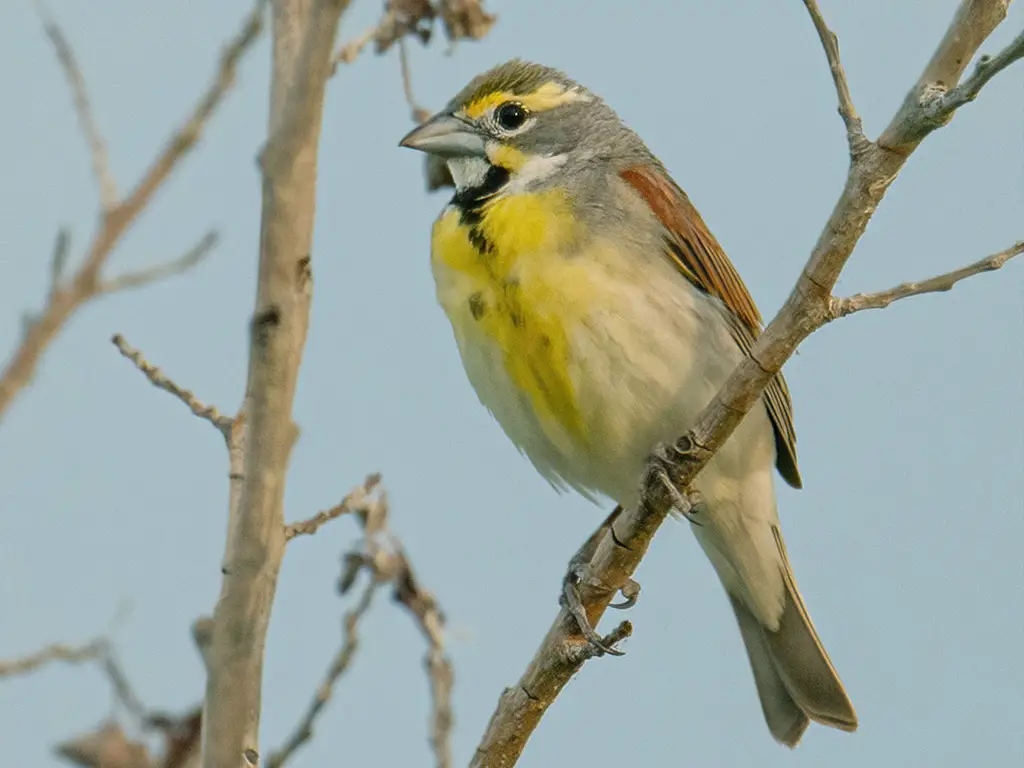
The dickcissel is a bird that is known for its small size and diet consisting mainly of seeds.
It belongs to the family Cardinalidae, which includes other bird species like cardinals and grosbeaks. This bird has a unique behavior of migration, which means it travels long distances seasonally.
During the breeding season, the dickcissel can be found in the prairie grasslands of the Midwestern United States.
These grasslands provide an ideal habitat for the birds to build nests and raise their young. However, when winter approaches, the dickcissel embarks on a journey to warmer regions. It migrates to Central America, specifically areas like northern Colombia and northern Venezuela.
These regions offer a more suitable climate and an abundance of food sources for the birds during the colder months. Migration is a vital survival strategy for the dickcissel as it allows them to escape harsh winter conditions and find better resources for their survival.
The availability of food plays a crucial role in determining the migratory patterns of birds like the dickcissel. During the migration, the dickcissel faces various challenges and obstacles.
They have to navigate long distances, often flying thousands of miles to reach their wintering grounds.
| Kingdom | Animalia |
| Phylum | Chordata |
| Clade | Dinosauria |
| Class | Aves |
| Order | Passeriformes |
| Family | Cardinalidae |
| Genus | Spiza |
| Species | S. americana |
23. Lawrence’s Goldfinch

Lawrence’s goldfinch is a small bird that is known for its irregular distribution pattern. It is primarily found breeding in California and Baja California.
During the breeding season, these goldfinches can be seen in these regions, building nests and raising their young. However, during the winter months, Lawrence’s goldfinch migrates to different areas. It is known to travel to the southwestern United States and northern Mexico.
These regions provide suitable wintering grounds for these birds, where they can find food and shelter. The erratic distribution of Lawrence’s goldfinch means that their presence is not predictable or consistent throughout the year.
They do not stay in one place for an extended period but rather move between their breeding and wintering grounds. The reason for this irregular distribution is not entirely understood. It could be influenced by factors such as food availability, climate, or habitat suitability.
These birds may follow specific patterns and migrate to areas where they can find the necessary resources to survive and reproduce successfully. Lawrence’s goldfinches are small songbirds, meaning they are known for their melodious calls and songs.
Their beautiful songs can often be heard during the breeding season when males use them to attract mates and establish territories.
| Kingdom | Animalia |
| Phylum | Chordata |
| Clade | Dinosauria |
| Class | Aves |
| Order | Passeriformes |
| Family | Fringillidae |
| Genus | Spinus |
| Species | S. lawrencei |
Conclusion
Yellow birds are a unique and vibrant species that can be found in the diverse landscapes of Nevada. They add a splash of color to the desert regions, as well as the mountainous areas of the state.
While their exact species and population numbers may vary, it is clear that yellow birds contribute to the overall biodiversity of Nevada.
Protecting their habitat and understanding their behavior can further enhance our appreciation and conservation efforts for these beautiful creatures.
Whether they are migratory or resident birds, their presence enriches the natural beauty and ecological balance of the Nevada wilderness.